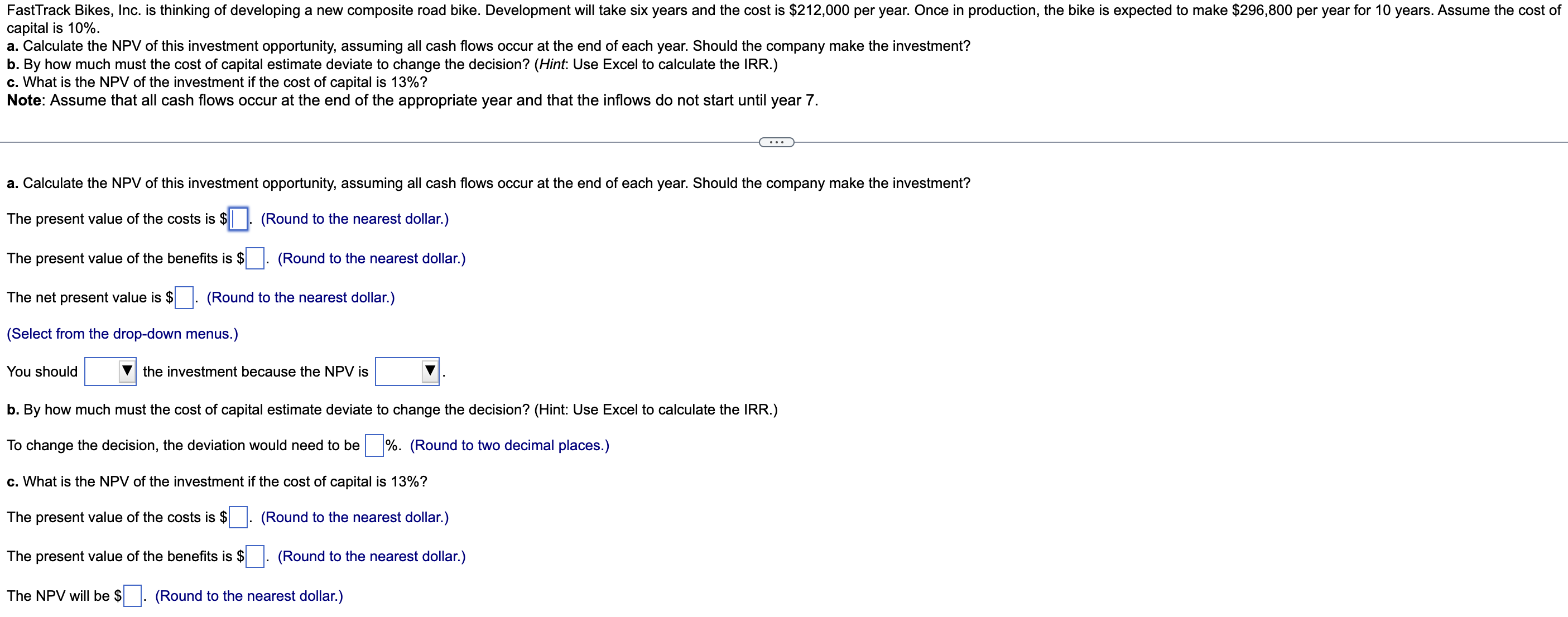Answered step by step
Verified Expert Solution
Question
1 Approved Answer
capital is 10%. a. Calculate the NPV of this investment opportunity, assuming all cash flows occur at the end of each year. Should the company
 capital is 10%. a. Calculate the NPV of this investment opportunity, assuming all cash flows occur at the end of each year. Should the company make the investment? b. By how much must the cost of capital estimate deviate to change the decision? (Hint: Use Excel to calculate the IRR.) c. What is the NPV of the investment if the cost of capital is 13% ? Note: Assume that all cash flows occur at the end of the appropriate year and that the inflows do not start until year 7 . a. Calculate the NPV of this investment opportunity, assuming all cash flows occur at the end of each year. Should the company make the investment? The present value of the costs is $ (Round to the nearest dollar.) The present value of the benefits is $[ (Round to the nearest dollar.) The net present value is $[ (Round to the nearest dollar.) (Select from the drop-down menus.) You should the investment because the NPV is b. By how much must the cost of capital estimate deviate to change the decision? (Hint: Use Excel to calculate the IRR.) To change the decision, the deviation would need to be %. (Round to two decimal places.) c. What is the NPV of the investment if the cost of capital is 13% ? The present value of the costs is ! (Round to the nearest dollar.) The present value of the benefits is $ (Round to the nearest dollar.) The NPV will be $ (Round to the nearest dollar.)
capital is 10%. a. Calculate the NPV of this investment opportunity, assuming all cash flows occur at the end of each year. Should the company make the investment? b. By how much must the cost of capital estimate deviate to change the decision? (Hint: Use Excel to calculate the IRR.) c. What is the NPV of the investment if the cost of capital is 13% ? Note: Assume that all cash flows occur at the end of the appropriate year and that the inflows do not start until year 7 . a. Calculate the NPV of this investment opportunity, assuming all cash flows occur at the end of each year. Should the company make the investment? The present value of the costs is $ (Round to the nearest dollar.) The present value of the benefits is $[ (Round to the nearest dollar.) The net present value is $[ (Round to the nearest dollar.) (Select from the drop-down menus.) You should the investment because the NPV is b. By how much must the cost of capital estimate deviate to change the decision? (Hint: Use Excel to calculate the IRR.) To change the decision, the deviation would need to be %. (Round to two decimal places.) c. What is the NPV of the investment if the cost of capital is 13% ? The present value of the costs is ! (Round to the nearest dollar.) The present value of the benefits is $ (Round to the nearest dollar.) The NPV will be $ (Round to the nearest dollar.) Step by Step Solution
There are 3 Steps involved in it
Step: 1

Get Instant Access to Expert-Tailored Solutions
See step-by-step solutions with expert insights and AI powered tools for academic success
Step: 2

Step: 3

Ace Your Homework with AI
Get the answers you need in no time with our AI-driven, step-by-step assistance
Get Started


